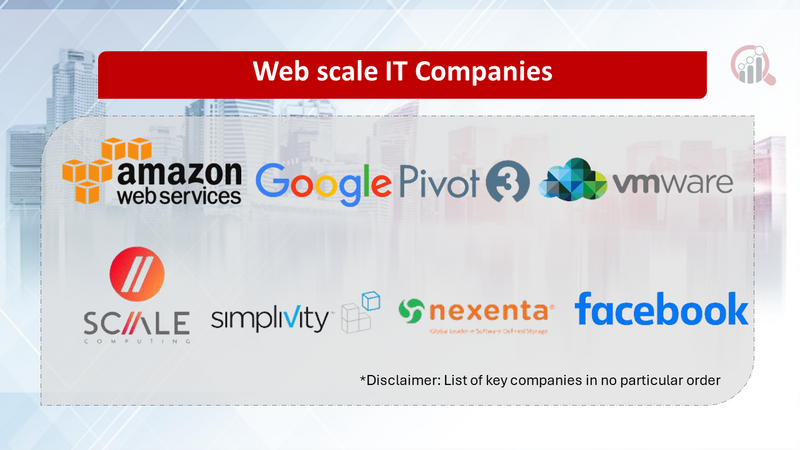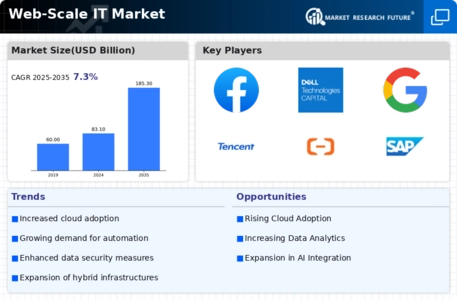Top Industry Leaders in the Web scale IT Market

Competitive Landscape of the Web-Scale IT Market
The web-scale IT market, encompassing technologies that cater to the demands of large-scale internet operations, is experiencing rapid growth fueled by digital transformation and cloud adoption. This dynamic landscape is teeming with established giants and nimble upstarts, each vying for a slice of the burgeoning pie. Understanding the competitive dynamics, key players, and investment trends is crucial for anyone navigating this exciting market.
Key Players:
- VMware Inc. (U.S.)
- Nutanix Inc. (U.S.)
- Amazon Web Services Inc. (U.S.)
- Rackspace Inc. (U.S.)
- Google Inc. (U.S.)
- Scale Computing Inc. (U.S.)
- Nexenta Systems Inc. (U.S.)
- SimpliVity Corporation (U.S.)
- Pivot3 Inc. (U.S.)
- Facebook Inc. (U.S.)
Strategies Adopted:
- Cloud-First Approach: Leading players are prioritizing cloud-based solutions, offering subscription models and managed services for easier adoption and scalability.
- Openness and Collaboration: Embracing open-source technologies and fostering collaboration with other vendors is becoming increasingly important to cater to diverse customer needs and build strong ecosystems.
- Focus on Automation and AI: Integrating automation and artificial intelligence into solutions is a key differentiator, enabling organizations to optimize operations, improve efficiency, and gain deeper insights.
- Security and Compliance: As data privacy regulations evolve, providing robust security features and compliance certifications is critical for gaining customer trust.
- Vertical Specialization: Tailoring solutions and services to specific industries like healthcare, finance, and retail can create competitive advantages.
Factors for Market Share Analysis:
- Revenue and Market Share: These metrics provide a quantitative understanding of a company's size and dominance.
- Customer Base and Adoption Rate: The number and size of customers, along with their rate of adoption, reflect a company's market traction and potential for future growth.
- Product Portfolio and Innovation: The breadth and depth of a company's offerings, coupled with its track record of innovation, indicate its ability to meet diverse customer needs and stay ahead of the curve.
- Brand Recognition and Reputation: A strong brand and positive reputation can attract new customers and drive loyalty.
- Pricing and Commercial Strategies: Pricing models, discounts, and partnerships can influence market share by making a company's offerings more attractive.
New and Emerging Companies:
- Startups focusing on niche areas: Companies like Databricks (cloud-based data platform) and Snowflake (cloud data warehouse) are addressing specific pain points in the web-scale market with innovative solutions.
- Security and compliance specialists: With increasing data privacy concerns, companies like Crowdstrike (cybersecurity) and Palo Alto Networks (security solutions) are gaining traction.
- Open-source software vendors: Rising adoption of open-source technologies is fueling the growth of companies like Elastic (search and analytics) and MongoDB (database).
Current Company Investment Trends:
- Hybrid and Multi-Cloud Solutions: Companies are investing in solutions that enable seamless management of workloads across different cloud platforms.
- Edge Computing: Investments are increasing in edge computing technologies to bring processing closer to data sources and reduce latency.
- Containerization and Serverless Computing: Companies are embracing containerization and serverless computing for increased agility and scalability.
- Artificial Intelligence and Machine Learning: Integration of AI and ML is becoming a top priority for optimizing operations, personalizing user experiences, and driving insights.
- Sustainability and Green IT: Companies are investing in sustainable solutions to reduce their carbon footprint and cater to environmentally conscious customers.
Technology Trends & Innovations:
- OpenStack celebrates 15th anniversary with focus on cloud-native advancements (Jan 24, 2024): The OpenStack open-source cloud computing platform marks its 15th year with renewed focus on cloud-native technologies and integration with containerization and microservices architectures.
- Edge computing takes center stage in 5G and IoT deployments (Jan 18, 2024): As 5G networks and IoT devices proliferate, the demand for edge computing solutions to process data closer to the source is skyrocketing, driving innovation in edge platforms and infrastructure.
- Serverless computing gains traction for event-driven and microservices applications (Jan 13, 2024): Serverless computing continues to disrupt traditional application development, offering scalability and cost-efficiency for event-driven and microservices-based architectures.

